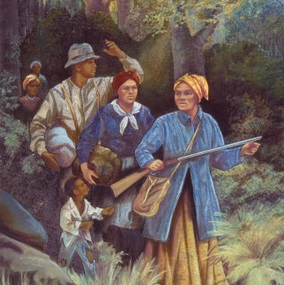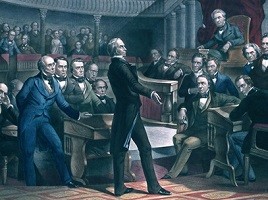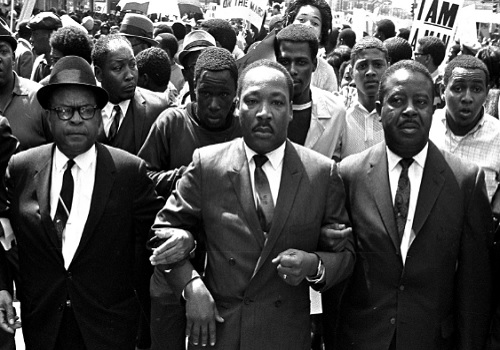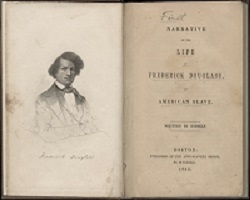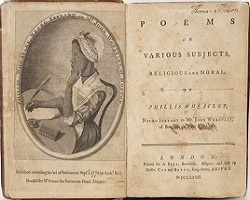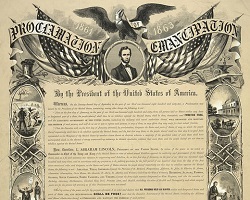Harriet Tubman, the Moses of her people
Harriet Tubman is the most widely recognized symbol of the Underground Railroad. When she escaped on September 17, 1849, Tubman was aided by members of the Underground Railroad. To her, freedom felt empty unless she could share it with people she loved so she resolved to go back and rescue friends and family. Harriet was nicknamed “Moses” by abolitionist William Lloyd Garrison. The name was used as an analogy to the biblical story of Moses who attempted to lead the Jews to the Promised Land and free them from slavery.
According to Sarah Hopkins Bradford, it is impossible to give accurate dates of her different journeys as she had no idea of the dates or the order in which they were made.
The Underground Railroad was a network of safe houses and transportation provided by abolitionists. The network was loosely organized and usually owners of safe houses did not know the entire network but just a few connecting stations. Over a period of time, Tubman was able to build her own network of connections with friends she trusted and who admired her. Secrecy was paramount. For those who decided to shelter slaves, the consequence of getting caught was going to jail for 6 months.
Harriet Tubman guided hundreds of slaves to freedom
.
First trip back
After Tubman escaped she found work in Philadelphia cleaning houses and managed to save some money. Harriet heard that her niece Kessiah and her children, James and Araminta, were about to be sold. She rushed south, crossing the Mason Dixon Line to Baltimore where she hid in the house of John Bowley, Kessiah’s husband who was a free African American. Bowley placed the winning bed on Kessiah and their children who immediately fled and found shelter in a safe house belonging to a free African American family. The following night they sailed to Baltimore where they met Tubman. She guided them to Philadelphia.
Tubman took his nephew James Bowley as a protégé. She paid for his school in St Catharines and became a school teacher. After the Civil War he returned to South Carolina where he taught freed men. He was later elected to the Legislature of Reconstruction in South Carolina.
Fugitive Slave Act
Next to be rescued was her brother Moses. By this time the Fugitive Slave Act of 1850 was in effect making her work more difficult and riskier. However she thought that returning over and over again was a risk worth taking. Because of the Fugitive Slave Act, slaves had to migrate further north to Canada. Frederick Douglass who lived in Rochester, NY hosted slaves on their way to St Catharines, Ontario. At one time he had 11 fugitives under his roof.
Escape strategies
Secret code language was used to communicate among Underground Railway supporters. Letters would usually contain code language just in case the letter got intercepted. Since most slaves were illiterate instructions were given by signal songs which had hidden messages only slaves could understand. Slaves sang spiritual songs praising God every day and were part of their own culture and tradition, masters usually encouraged it. Coded songs contained words giving directions on how to escape or where to meet. They used Biblical references and analogies of Biblical people, places and stories, comparing them to their own history of slavery. For example, “being bound for the land of Canaan” for a white person could mean ready to die and go to heaven; but to a slave it meant ready to go to Canada. Many coded songs became popular among slaves such as Steal Away, Geo on Board, Little Children, Wade in the Water, Swing Low Sweet Chariot and Follow the Drinking Gourd. For lyrics of these and more songs click here.
Harriet Tubman developed strategies throughout her years liberating slaves. To have a head start she urged slaves to escape their masters on Saturday, as Sunday was a day for rest and the owner would not find out until Monday morning. In addition, notices on runaways would not be published until Monday. Tubman always traveled at night and rested during the day, she preferred to travel during the fall season and occasionally in the spring. Summers had longer days. She followed the North Star and when it was a cloudy night she would observe the moss growing on the north side of dead tree trunks. In order to avoid slave catchers she would use back roads, waterways, mountains and swamps. Tubman always carried a gun for self protection and to urge slaves not to give up.
Moses and her supporters
During the period of 1849 until 1855 her reputation as the liberator of her people started to build up. She continued to live in Philadelphia working and saving money. The more trips she took the more confidence she gained. During this time she made friends with abolitionist who admired her courage. One of her early supporters was Lucretia Mott, an abolitionist and women’s rights advocate. It is believed that through her, Tubman gained access to powerful reformers such as William Lloyd Garrison, Frederick Douglass and Martha Coffin Wright.
William Lloyd Garrison called her “Moses” and John Brown, “General Tubman”. Over time she built up her own network of Northern Underground Railway operatives and routes: William Still in Philadelphia, Thomas Garrett in Wilmington, Delaware; Stephan Myers in Albany, NY; Jermain Loguen in Syracuse, NY and Frederick Douglass in Rochester, NY. They or their contacts provided safe houses and shelter. Rochester was the last station before crossing the Niagara Falls Bridge into St. Catharines, Ontario.
For 10 years Tubman returned 19 times liberating around 300 slaves. She was proud to have “never lost a passenger”. Tubman’s missions were admired by those who supported the abolition of slavery. Black and white abolitionist provided her with funds to continue her activities.
Liberating her parents
One of Tubman’s last operations was to bring her parents north. The area of the states bordering the Mason Dixon Line was hostile to free African Americans, some groups wanted to expel them from the state and only keep those enslaved ones. Tubman’s father, Ben Ross, was under suspicion of helping fugitive slaves and under the eye of many slave holders.
Ben was a free man but his wife, Harriet’s mother, Rit was not free. A provision in Eliza’s Brodess grandfather’s will stated that Rit and her children be manumitted when they turned 45 years old. Rit was older than that but Eliza was determined not to let her go for free. In 1855 Ben purchased his wife Rit from Eliza Brodess for $20.
In 1857 Ben was in trouble with the authorities for having harbored fugitives in his home. Harriet rushed south to help her parents in what would be her only known expedition to have taken place in the summer. It was a challenge to transport her elderly parents who could not walk long distances. She improvised a carriage and managed to transport them to Canada. They settled in St Catharines where other relatives had settled. Upon arrival in Canada the Rosses changed their last name to Steward, taking their son’s adopted last name.
Tubman moved from Philadelphia to St Catharines to help her parents but her mother complaint of the harsh Canadian winter. Tubman and her parents relocated to Auburn, New York where she bought 7 acres of land from her friend William Seward, for the generous amount of $1,200.
Tubman’s last trip
For a decade Tubman was trying to rescue her sister Rachel but was unsuccessful. In December 1860 Tubman arrived in Dorchester Country to retrieve Rachel and her two young children, Ben and Angerine, but only to find out that Rachel had passed away. Tubman was unable to find her children. Instead of returning empty handed, Harriet brought the Ennals family. The Ennals had an infant who had be drugged with paregoric in order to keep quiet as there were many slave catchers. After weeks of traveling north the Ennals arrived safely in St Catharines, Ontario.
This was Tubman’s last trip on the Underground Railroad. The following year saw the start of the American Civil War and the effort was moved “above ground”. Tubman was initially involved as a nurse, cook and recruiter. Subsequently she worked as a spy and scout. See role of Harriet Tubman in the Civil War.
Category: Biography, Underground Railroad
